Project Risk Management Case Study: Regional Rail Fleet in WA
VerifiedAdded on 2023/01/20
|18
|4391
|97
Case Study
AI Summary
This report presents a comprehensive case study on project risk management, specifically focusing on the Regional Rail Fleet project between Perth and Western Australia. The study, assuming Momentum Trains' involvement, details the application of both qualitative and quantitative risk analysis to identify potential project threats. The report emphasizes the development of a robust risk mitigation plan, incorporating a risk assessment matrix to address identified risks. It covers risk identification, analysis, response planning, monitoring, and control, as well as the roles and responsibilities of project associates. The analysis considers various risk factors, including improper maintenance, safety concerns, supplier risks, and communication issues. The study highlights the importance of a proactive risk management approach to ensure project success, timely delivery, and consumer satisfaction, ultimately aiming to provide a comfortable and secure travel experience for passengers. The report also provides recommendations for future project implementation.
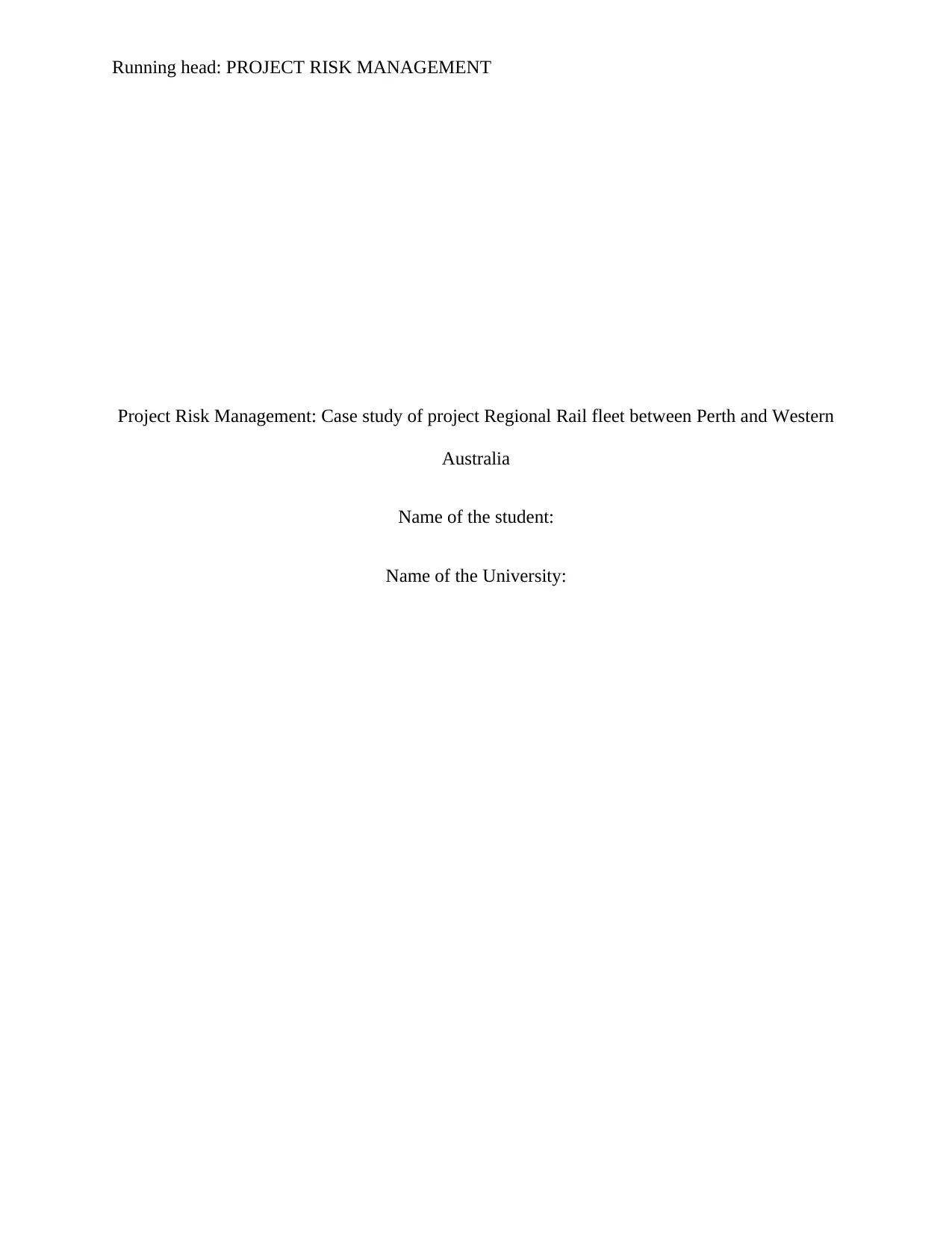
Running head: PROJECT RISK MANAGEMENT
Project Risk Management: Case study of project Regional Rail fleet between Perth and Western
Australia
Name of the student:
Name of the University:
Project Risk Management: Case study of project Regional Rail fleet between Perth and Western
Australia
Name of the student:
Name of the University:
Paraphrase This Document
Need a fresh take? Get an instant paraphrase of this document with our AI Paraphraser

1PROJECT RISK MANAGEMENT
Executive Summary
This report reflects the essential use of risk management plan for the Regional Rail fleet project
and the roles of a risk manager or risk consultant for developing a railway system. This project is
assumed to be assigned to Momentum trains so that it could be implemented within estimated
budget and time between Perth and Regional centre in Western Australia. In order to analyze the
risks both qualitative and quantitative risk analysis processes are applied in this report. A
respective risk mitigation plan is also developed through a risk assessment matrix or risk register.
The possibilities and impact of risks are also identified in this project. It is assumed that if proper
risk management plan is designed while implementing the old train replacement project then it
would be able to deliver a comfortable and secured travelling experience to the consumers.
Executive Summary
This report reflects the essential use of risk management plan for the Regional Rail fleet project
and the roles of a risk manager or risk consultant for developing a railway system. This project is
assumed to be assigned to Momentum trains so that it could be implemented within estimated
budget and time between Perth and Regional centre in Western Australia. In order to analyze the
risks both qualitative and quantitative risk analysis processes are applied in this report. A
respective risk mitigation plan is also developed through a risk assessment matrix or risk register.
The possibilities and impact of risks are also identified in this project. It is assumed that if proper
risk management plan is designed while implementing the old train replacement project then it
would be able to deliver a comfortable and secured travelling experience to the consumers.
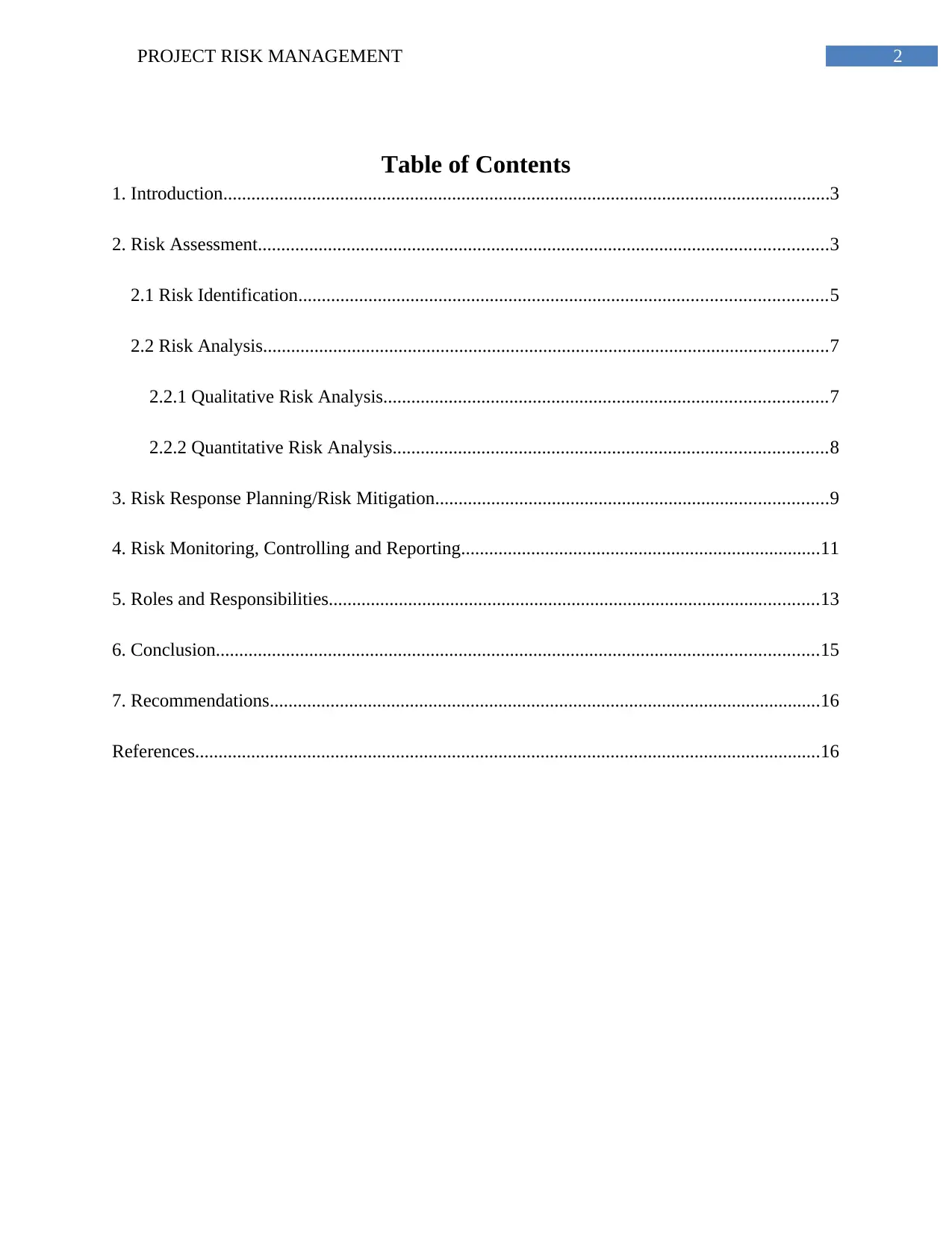
2PROJECT RISK MANAGEMENT
Table of Contents
1. Introduction..................................................................................................................................3
2. Risk Assessment..........................................................................................................................3
2.1 Risk Identification.................................................................................................................5
2.2 Risk Analysis.........................................................................................................................7
2.2.1 Qualitative Risk Analysis...............................................................................................7
2.2.2 Quantitative Risk Analysis.............................................................................................8
3. Risk Response Planning/Risk Mitigation....................................................................................9
4. Risk Monitoring, Controlling and Reporting.............................................................................11
5. Roles and Responsibilities.........................................................................................................13
6. Conclusion.................................................................................................................................15
7. Recommendations......................................................................................................................16
References......................................................................................................................................16
Table of Contents
1. Introduction..................................................................................................................................3
2. Risk Assessment..........................................................................................................................3
2.1 Risk Identification.................................................................................................................5
2.2 Risk Analysis.........................................................................................................................7
2.2.1 Qualitative Risk Analysis...............................................................................................7
2.2.2 Quantitative Risk Analysis.............................................................................................8
3. Risk Response Planning/Risk Mitigation....................................................................................9
4. Risk Monitoring, Controlling and Reporting.............................................................................11
5. Roles and Responsibilities.........................................................................................................13
6. Conclusion.................................................................................................................................15
7. Recommendations......................................................................................................................16
References......................................................................................................................................16
⊘ This is a preview!⊘
Do you want full access?
Subscribe today to unlock all pages.

Trusted by 1+ million students worldwide

3PROJECT RISK MANAGEMENT
1. Introduction
Risk management planning is referred to as one of the most crucial knowledge
management areas in the professional project management prcatices that helps to identify
potential risks, its impact, possibility of occurrences and mitigation strategies for the respective
risks. Implementation of appropriate risk management plan always helps the project associates to
identify the risks before initiating any project. The case study project nominated in this report is
Regional Rail fleet. In order to implement this project the Australian government has established
a contract to Momentum Trains.
The Australian government is focuses on replacing XPLORER, Endeavour trains and
regional Rain fleet of XPT for the 40 years old trains. In order to simulate the regional economy
and to offer long terms as well as sustainable job opportunities the Australian government is
focused on building new and advanced train maintenance facilities. The project includes
building, financing, maintaining the new Regional rail fleet facilities. Besides risk controlling,
monitoring and reporting the roles and responsibilities needed to be served by individual project
associates are also identified in this report.
2. Risk Assessment
Risk assessment is the widely used project management process which describes the
complete process or methods where risk factors and potential hazards can be easily identified
which can cause harm in the successful project lines. Risk assessment process can analyze and
evaluate all possible risks related to the identified hazards. Risk assessment plan is comprises of
five individual steps such as risk identification, risk analysis, risk assessment, risk prioritization
1. Introduction
Risk management planning is referred to as one of the most crucial knowledge
management areas in the professional project management prcatices that helps to identify
potential risks, its impact, possibility of occurrences and mitigation strategies for the respective
risks. Implementation of appropriate risk management plan always helps the project associates to
identify the risks before initiating any project. The case study project nominated in this report is
Regional Rail fleet. In order to implement this project the Australian government has established
a contract to Momentum Trains.
The Australian government is focuses on replacing XPLORER, Endeavour trains and
regional Rain fleet of XPT for the 40 years old trains. In order to simulate the regional economy
and to offer long terms as well as sustainable job opportunities the Australian government is
focused on building new and advanced train maintenance facilities. The project includes
building, financing, maintaining the new Regional rail fleet facilities. Besides risk controlling,
monitoring and reporting the roles and responsibilities needed to be served by individual project
associates are also identified in this report.
2. Risk Assessment
Risk assessment is the widely used project management process which describes the
complete process or methods where risk factors and potential hazards can be easily identified
which can cause harm in the successful project lines. Risk assessment process can analyze and
evaluate all possible risks related to the identified hazards. Risk assessment plan is comprises of
five individual steps such as risk identification, risk analysis, risk assessment, risk prioritization
Paraphrase This Document
Need a fresh take? Get an instant paraphrase of this document with our AI Paraphraser
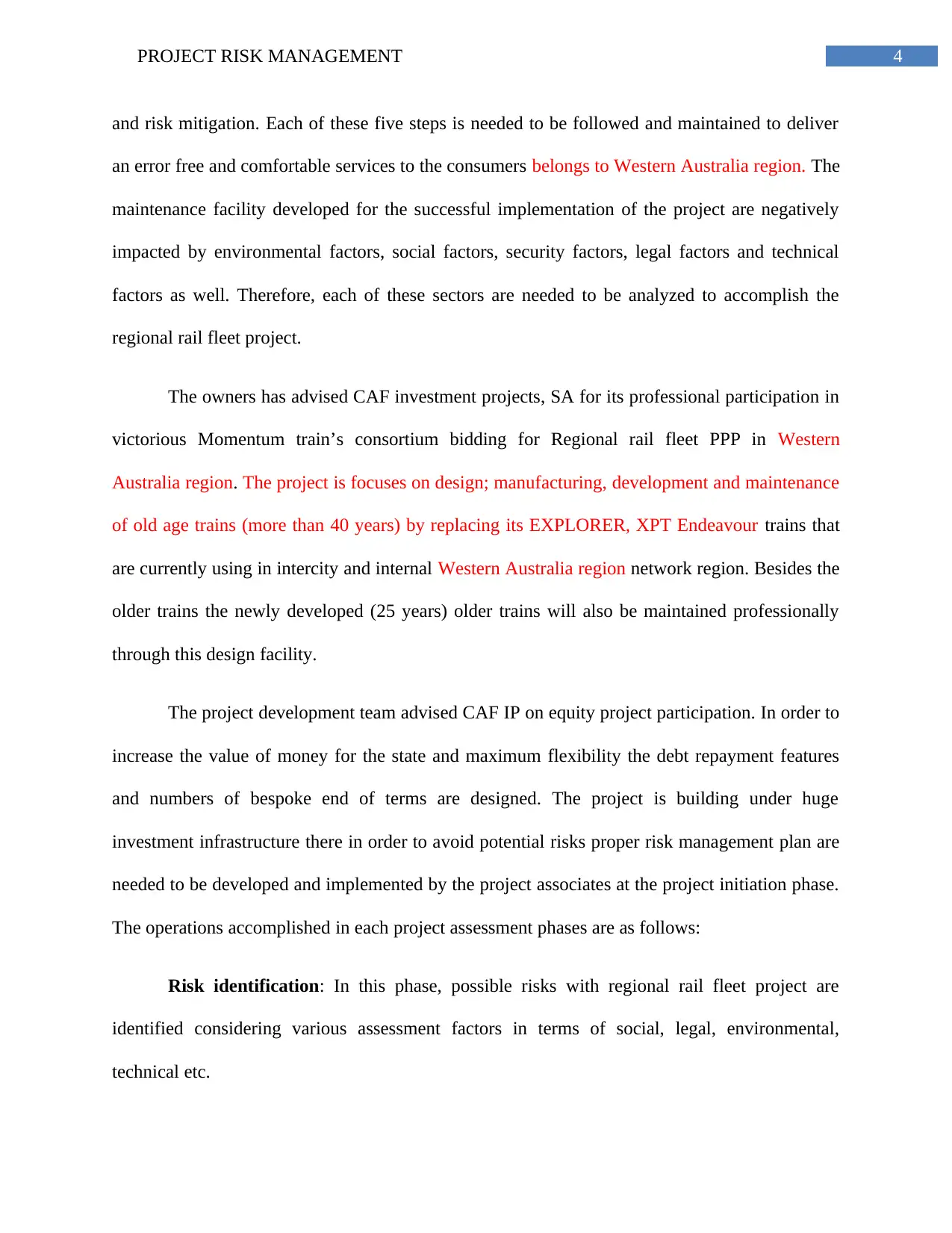
4PROJECT RISK MANAGEMENT
and risk mitigation. Each of these five steps is needed to be followed and maintained to deliver
an error free and comfortable services to the consumers belongs to Western Australia region. The
maintenance facility developed for the successful implementation of the project are negatively
impacted by environmental factors, social factors, security factors, legal factors and technical
factors as well. Therefore, each of these sectors are needed to be analyzed to accomplish the
regional rail fleet project.
The owners has advised CAF investment projects, SA for its professional participation in
victorious Momentum train’s consortium bidding for Regional rail fleet PPP in Western
Australia region. The project is focuses on design; manufacturing, development and maintenance
of old age trains (more than 40 years) by replacing its EXPLORER, XPT Endeavour trains that
are currently using in intercity and internal Western Australia region network region. Besides the
older trains the newly developed (25 years) older trains will also be maintained professionally
through this design facility.
The project development team advised CAF IP on equity project participation. In order to
increase the value of money for the state and maximum flexibility the debt repayment features
and numbers of bespoke end of terms are designed. The project is building under huge
investment infrastructure there in order to avoid potential risks proper risk management plan are
needed to be developed and implemented by the project associates at the project initiation phase.
The operations accomplished in each project assessment phases are as follows:
Risk identification: In this phase, possible risks with regional rail fleet project are
identified considering various assessment factors in terms of social, legal, environmental,
technical etc.
and risk mitigation. Each of these five steps is needed to be followed and maintained to deliver
an error free and comfortable services to the consumers belongs to Western Australia region. The
maintenance facility developed for the successful implementation of the project are negatively
impacted by environmental factors, social factors, security factors, legal factors and technical
factors as well. Therefore, each of these sectors are needed to be analyzed to accomplish the
regional rail fleet project.
The owners has advised CAF investment projects, SA for its professional participation in
victorious Momentum train’s consortium bidding for Regional rail fleet PPP in Western
Australia region. The project is focuses on design; manufacturing, development and maintenance
of old age trains (more than 40 years) by replacing its EXPLORER, XPT Endeavour trains that
are currently using in intercity and internal Western Australia region network region. Besides the
older trains the newly developed (25 years) older trains will also be maintained professionally
through this design facility.
The project development team advised CAF IP on equity project participation. In order to
increase the value of money for the state and maximum flexibility the debt repayment features
and numbers of bespoke end of terms are designed. The project is building under huge
investment infrastructure there in order to avoid potential risks proper risk management plan are
needed to be developed and implemented by the project associates at the project initiation phase.
The operations accomplished in each project assessment phases are as follows:
Risk identification: In this phase, possible risks with regional rail fleet project are
identified considering various assessment factors in terms of social, legal, environmental,
technical etc.
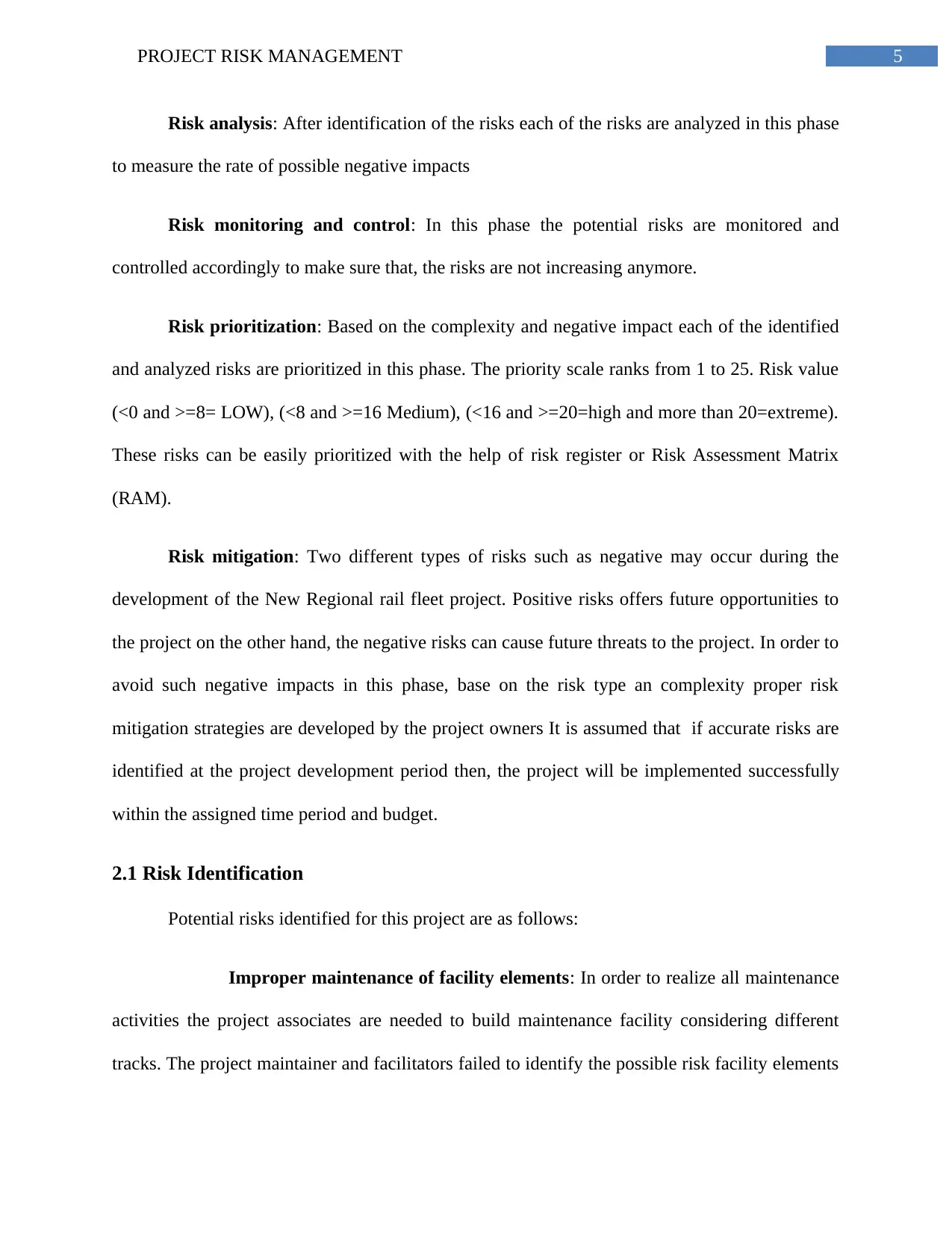
5PROJECT RISK MANAGEMENT
Risk analysis: After identification of the risks each of the risks are analyzed in this phase
to measure the rate of possible negative impacts
Risk monitoring and control: In this phase the potential risks are monitored and
controlled accordingly to make sure that, the risks are not increasing anymore.
Risk prioritization: Based on the complexity and negative impact each of the identified
and analyzed risks are prioritized in this phase. The priority scale ranks from 1 to 25. Risk value
(<0 and >=8= LOW), (<8 and >=16 Medium), (<16 and >=20=high and more than 20=extreme).
These risks can be easily prioritized with the help of risk register or Risk Assessment Matrix
(RAM).
Risk mitigation: Two different types of risks such as negative may occur during the
development of the New Regional rail fleet project. Positive risks offers future opportunities to
the project on the other hand, the negative risks can cause future threats to the project. In order to
avoid such negative impacts in this phase, base on the risk type an complexity proper risk
mitigation strategies are developed by the project owners It is assumed that if accurate risks are
identified at the project development period then, the project will be implemented successfully
within the assigned time period and budget.
2.1 Risk Identification
Potential risks identified for this project are as follows:
Improper maintenance of facility elements: In order to realize all maintenance
activities the project associates are needed to build maintenance facility considering different
tracks. The project maintainer and facilitators failed to identify the possible risk facility elements
Risk analysis: After identification of the risks each of the risks are analyzed in this phase
to measure the rate of possible negative impacts
Risk monitoring and control: In this phase the potential risks are monitored and
controlled accordingly to make sure that, the risks are not increasing anymore.
Risk prioritization: Based on the complexity and negative impact each of the identified
and analyzed risks are prioritized in this phase. The priority scale ranks from 1 to 25. Risk value
(<0 and >=8= LOW), (<8 and >=16 Medium), (<16 and >=20=high and more than 20=extreme).
These risks can be easily prioritized with the help of risk register or Risk Assessment Matrix
(RAM).
Risk mitigation: Two different types of risks such as negative may occur during the
development of the New Regional rail fleet project. Positive risks offers future opportunities to
the project on the other hand, the negative risks can cause future threats to the project. In order to
avoid such negative impacts in this phase, base on the risk type an complexity proper risk
mitigation strategies are developed by the project owners It is assumed that if accurate risks are
identified at the project development period then, the project will be implemented successfully
within the assigned time period and budget.
2.1 Risk Identification
Potential risks identified for this project are as follows:
Improper maintenance of facility elements: In order to realize all maintenance
activities the project associates are needed to build maintenance facility considering different
tracks. The project maintainer and facilitators failed to identify the possible risk facility elements
⊘ This is a preview!⊘
Do you want full access?
Subscribe today to unlock all pages.

Trusted by 1+ million students worldwide
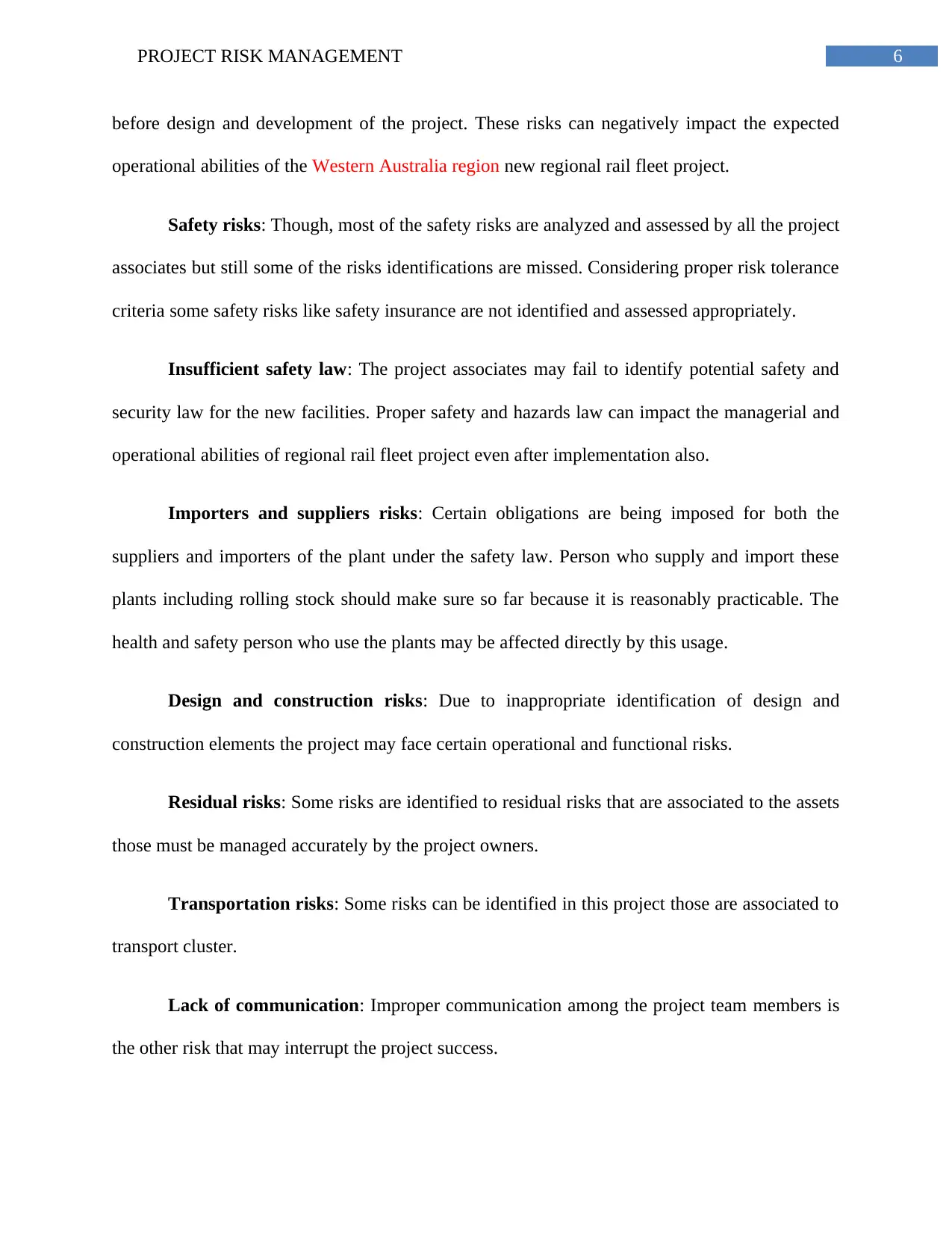
6PROJECT RISK MANAGEMENT
before design and development of the project. These risks can negatively impact the expected
operational abilities of the Western Australia region new regional rail fleet project.
Safety risks: Though, most of the safety risks are analyzed and assessed by all the project
associates but still some of the risks identifications are missed. Considering proper risk tolerance
criteria some safety risks like safety insurance are not identified and assessed appropriately.
Insufficient safety law: The project associates may fail to identify potential safety and
security law for the new facilities. Proper safety and hazards law can impact the managerial and
operational abilities of regional rail fleet project even after implementation also.
Importers and suppliers risks: Certain obligations are being imposed for both the
suppliers and importers of the plant under the safety law. Person who supply and import these
plants including rolling stock should make sure so far because it is reasonably practicable. The
health and safety person who use the plants may be affected directly by this usage.
Design and construction risks: Due to inappropriate identification of design and
construction elements the project may face certain operational and functional risks.
Residual risks: Some risks are identified to residual risks that are associated to the assets
those must be managed accurately by the project owners.
Transportation risks: Some risks can be identified in this project those are associated to
transport cluster.
Lack of communication: Improper communication among the project team members is
the other risk that may interrupt the project success.
before design and development of the project. These risks can negatively impact the expected
operational abilities of the Western Australia region new regional rail fleet project.
Safety risks: Though, most of the safety risks are analyzed and assessed by all the project
associates but still some of the risks identifications are missed. Considering proper risk tolerance
criteria some safety risks like safety insurance are not identified and assessed appropriately.
Insufficient safety law: The project associates may fail to identify potential safety and
security law for the new facilities. Proper safety and hazards law can impact the managerial and
operational abilities of regional rail fleet project even after implementation also.
Importers and suppliers risks: Certain obligations are being imposed for both the
suppliers and importers of the plant under the safety law. Person who supply and import these
plants including rolling stock should make sure so far because it is reasonably practicable. The
health and safety person who use the plants may be affected directly by this usage.
Design and construction risks: Due to inappropriate identification of design and
construction elements the project may face certain operational and functional risks.
Residual risks: Some risks are identified to residual risks that are associated to the assets
those must be managed accurately by the project owners.
Transportation risks: Some risks can be identified in this project those are associated to
transport cluster.
Lack of communication: Improper communication among the project team members is
the other risk that may interrupt the project success.
Paraphrase This Document
Need a fresh take? Get an instant paraphrase of this document with our AI Paraphraser
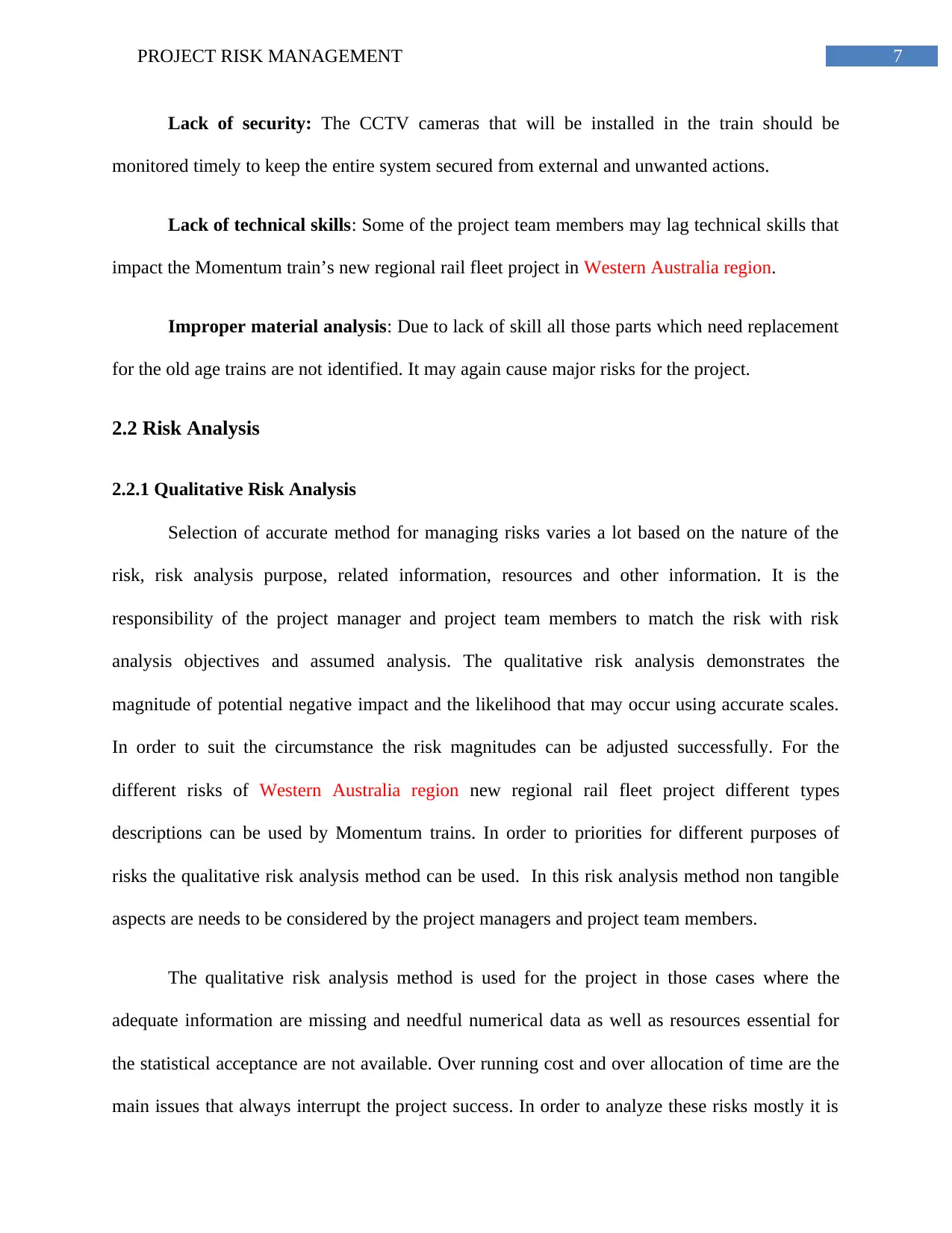
7PROJECT RISK MANAGEMENT
Lack of security: The CCTV cameras that will be installed in the train should be
monitored timely to keep the entire system secured from external and unwanted actions.
Lack of technical skills: Some of the project team members may lag technical skills that
impact the Momentum train’s new regional rail fleet project in Western Australia region.
Improper material analysis: Due to lack of skill all those parts which need replacement
for the old age trains are not identified. It may again cause major risks for the project.
2.2 Risk Analysis
2.2.1 Qualitative Risk Analysis
Selection of accurate method for managing risks varies a lot based on the nature of the
risk, risk analysis purpose, related information, resources and other information. It is the
responsibility of the project manager and project team members to match the risk with risk
analysis objectives and assumed analysis. The qualitative risk analysis demonstrates the
magnitude of potential negative impact and the likelihood that may occur using accurate scales.
In order to suit the circumstance the risk magnitudes can be adjusted successfully. For the
different risks of Western Australia region new regional rail fleet project different types
descriptions can be used by Momentum trains. In order to priorities for different purposes of
risks the qualitative risk analysis method can be used. In this risk analysis method non tangible
aspects are needs to be considered by the project managers and project team members.
The qualitative risk analysis method is used for the project in those cases where the
adequate information are missing and needful numerical data as well as resources essential for
the statistical acceptance are not available. Over running cost and over allocation of time are the
main issues that always interrupt the project success. In order to analyze these risks mostly it is
Lack of security: The CCTV cameras that will be installed in the train should be
monitored timely to keep the entire system secured from external and unwanted actions.
Lack of technical skills: Some of the project team members may lag technical skills that
impact the Momentum train’s new regional rail fleet project in Western Australia region.
Improper material analysis: Due to lack of skill all those parts which need replacement
for the old age trains are not identified. It may again cause major risks for the project.
2.2 Risk Analysis
2.2.1 Qualitative Risk Analysis
Selection of accurate method for managing risks varies a lot based on the nature of the
risk, risk analysis purpose, related information, resources and other information. It is the
responsibility of the project manager and project team members to match the risk with risk
analysis objectives and assumed analysis. The qualitative risk analysis demonstrates the
magnitude of potential negative impact and the likelihood that may occur using accurate scales.
In order to suit the circumstance the risk magnitudes can be adjusted successfully. For the
different risks of Western Australia region new regional rail fleet project different types
descriptions can be used by Momentum trains. In order to priorities for different purposes of
risks the qualitative risk analysis method can be used. In this risk analysis method non tangible
aspects are needs to be considered by the project managers and project team members.
The qualitative risk analysis method is used for the project in those cases where the
adequate information are missing and needful numerical data as well as resources essential for
the statistical acceptance are not available. Over running cost and over allocation of time are the
main issues that always interrupt the project success. In order to analyze these risks mostly it is
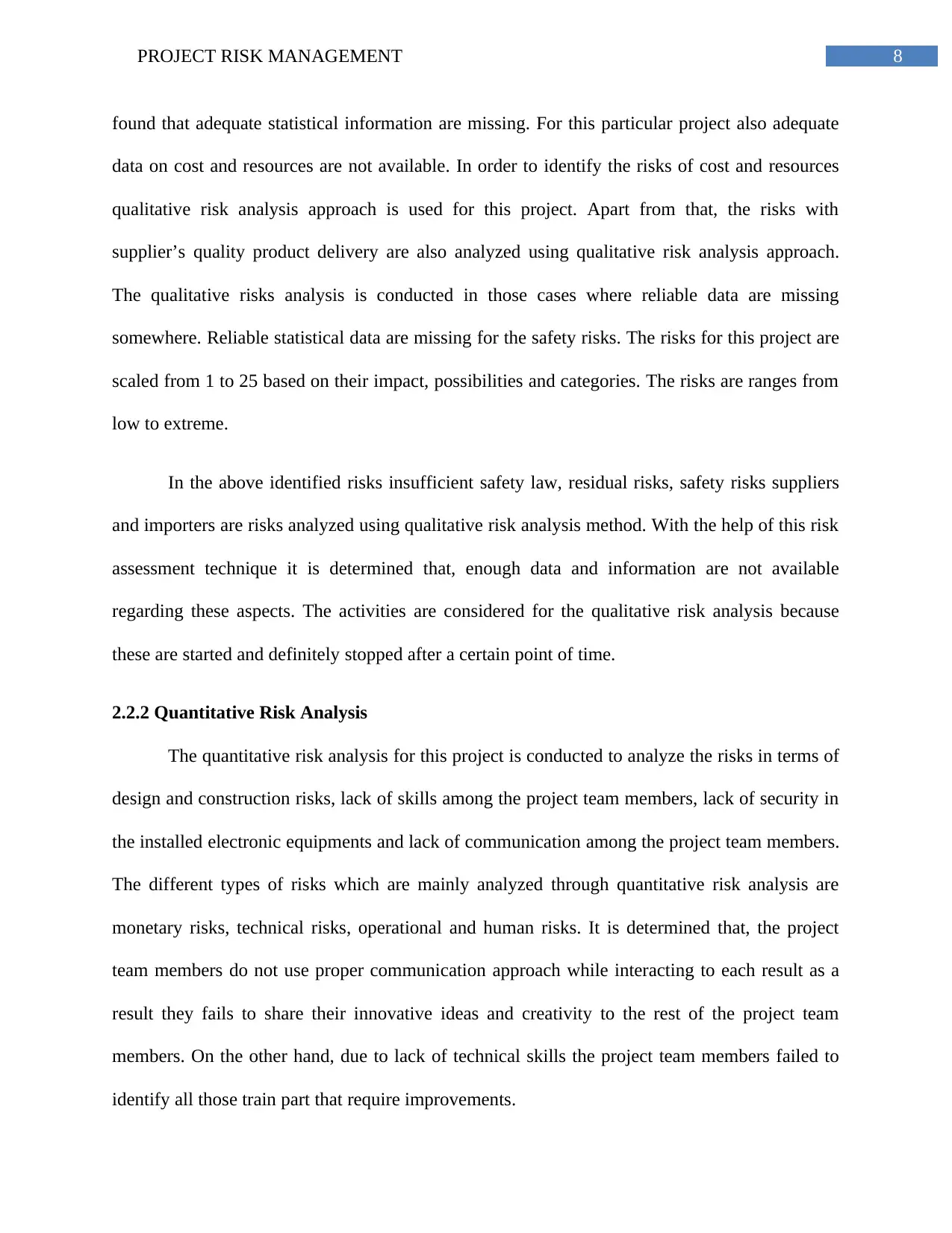
8PROJECT RISK MANAGEMENT
found that adequate statistical information are missing. For this particular project also adequate
data on cost and resources are not available. In order to identify the risks of cost and resources
qualitative risk analysis approach is used for this project. Apart from that, the risks with
supplier’s quality product delivery are also analyzed using qualitative risk analysis approach.
The qualitative risks analysis is conducted in those cases where reliable data are missing
somewhere. Reliable statistical data are missing for the safety risks. The risks for this project are
scaled from 1 to 25 based on their impact, possibilities and categories. The risks are ranges from
low to extreme.
In the above identified risks insufficient safety law, residual risks, safety risks suppliers
and importers are risks analyzed using qualitative risk analysis method. With the help of this risk
assessment technique it is determined that, enough data and information are not available
regarding these aspects. The activities are considered for the qualitative risk analysis because
these are started and definitely stopped after a certain point of time.
2.2.2 Quantitative Risk Analysis
The quantitative risk analysis for this project is conducted to analyze the risks in terms of
design and construction risks, lack of skills among the project team members, lack of security in
the installed electronic equipments and lack of communication among the project team members.
The different types of risks which are mainly analyzed through quantitative risk analysis are
monetary risks, technical risks, operational and human risks. It is determined that, the project
team members do not use proper communication approach while interacting to each result as a
result they fails to share their innovative ideas and creativity to the rest of the project team
members. On the other hand, due to lack of technical skills the project team members failed to
identify all those train part that require improvements.
found that adequate statistical information are missing. For this particular project also adequate
data on cost and resources are not available. In order to identify the risks of cost and resources
qualitative risk analysis approach is used for this project. Apart from that, the risks with
supplier’s quality product delivery are also analyzed using qualitative risk analysis approach.
The qualitative risks analysis is conducted in those cases where reliable data are missing
somewhere. Reliable statistical data are missing for the safety risks. The risks for this project are
scaled from 1 to 25 based on their impact, possibilities and categories. The risks are ranges from
low to extreme.
In the above identified risks insufficient safety law, residual risks, safety risks suppliers
and importers are risks analyzed using qualitative risk analysis method. With the help of this risk
assessment technique it is determined that, enough data and information are not available
regarding these aspects. The activities are considered for the qualitative risk analysis because
these are started and definitely stopped after a certain point of time.
2.2.2 Quantitative Risk Analysis
The quantitative risk analysis for this project is conducted to analyze the risks in terms of
design and construction risks, lack of skills among the project team members, lack of security in
the installed electronic equipments and lack of communication among the project team members.
The different types of risks which are mainly analyzed through quantitative risk analysis are
monetary risks, technical risks, operational and human risks. It is determined that, the project
team members do not use proper communication approach while interacting to each result as a
result they fails to share their innovative ideas and creativity to the rest of the project team
members. On the other hand, due to lack of technical skills the project team members failed to
identify all those train part that require improvements.
⊘ This is a preview!⊘
Do you want full access?
Subscribe today to unlock all pages.

Trusted by 1+ million students worldwide
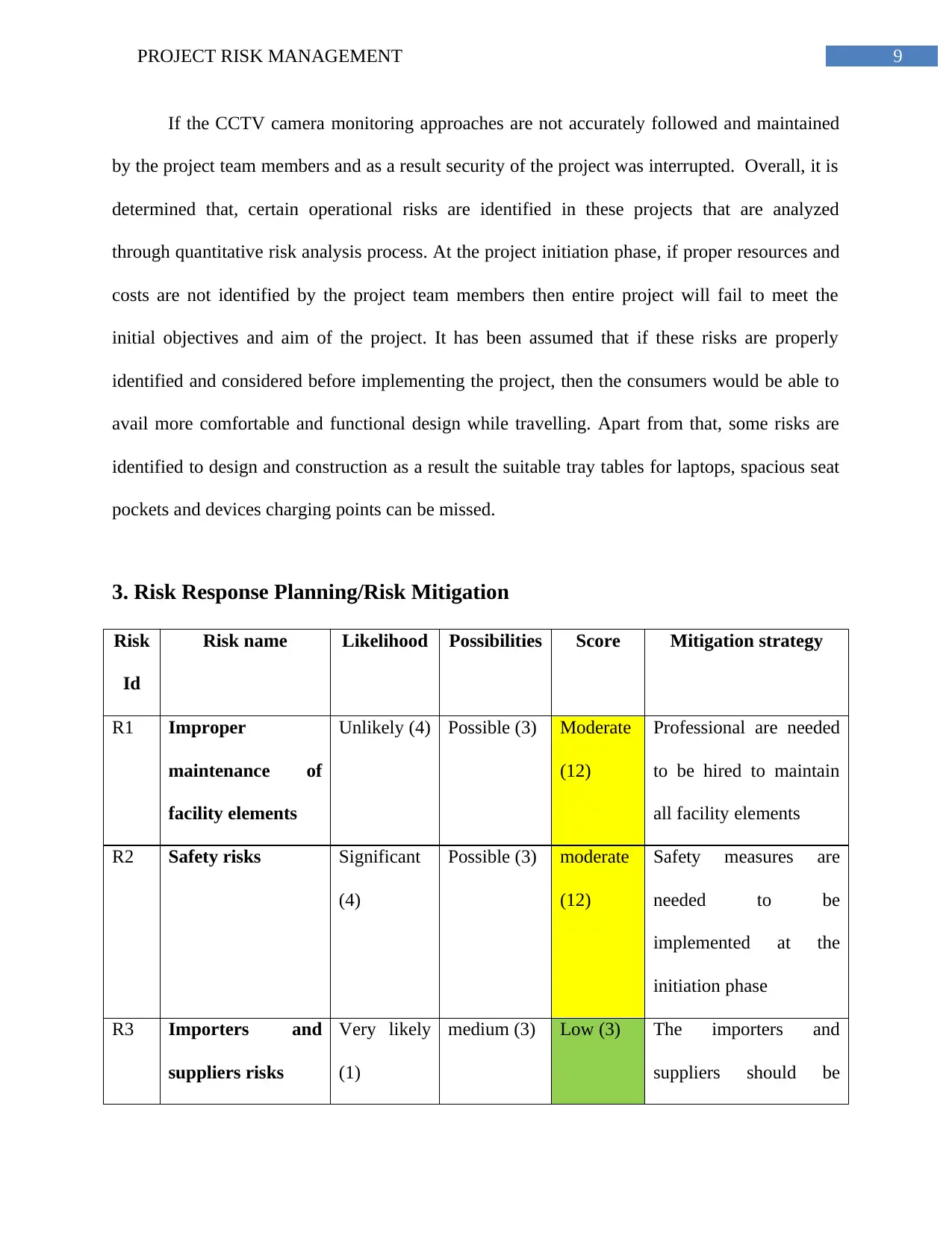
9PROJECT RISK MANAGEMENT
If the CCTV camera monitoring approaches are not accurately followed and maintained
by the project team members and as a result security of the project was interrupted. Overall, it is
determined that, certain operational risks are identified in these projects that are analyzed
through quantitative risk analysis process. At the project initiation phase, if proper resources and
costs are not identified by the project team members then entire project will fail to meet the
initial objectives and aim of the project. It has been assumed that if these risks are properly
identified and considered before implementing the project, then the consumers would be able to
avail more comfortable and functional design while travelling. Apart from that, some risks are
identified to design and construction as a result the suitable tray tables for laptops, spacious seat
pockets and devices charging points can be missed.
3. Risk Response Planning/Risk Mitigation
Risk
Id
Risk name Likelihood Possibilities Score Mitigation strategy
R1 Improper
maintenance of
facility elements
Unlikely (4) Possible (3) Moderate
(12)
Professional are needed
to be hired to maintain
all facility elements
R2 Safety risks Significant
(4)
Possible (3) moderate
(12)
Safety measures are
needed to be
implemented at the
initiation phase
R3 Importers and
suppliers risks
Very likely
(1)
medium (3) Low (3) The importers and
suppliers should be
If the CCTV camera monitoring approaches are not accurately followed and maintained
by the project team members and as a result security of the project was interrupted. Overall, it is
determined that, certain operational risks are identified in these projects that are analyzed
through quantitative risk analysis process. At the project initiation phase, if proper resources and
costs are not identified by the project team members then entire project will fail to meet the
initial objectives and aim of the project. It has been assumed that if these risks are properly
identified and considered before implementing the project, then the consumers would be able to
avail more comfortable and functional design while travelling. Apart from that, some risks are
identified to design and construction as a result the suitable tray tables for laptops, spacious seat
pockets and devices charging points can be missed.
3. Risk Response Planning/Risk Mitigation
Risk
Id
Risk name Likelihood Possibilities Score Mitigation strategy
R1 Improper
maintenance of
facility elements
Unlikely (4) Possible (3) Moderate
(12)
Professional are needed
to be hired to maintain
all facility elements
R2 Safety risks Significant
(4)
Possible (3) moderate
(12)
Safety measures are
needed to be
implemented at the
initiation phase
R3 Importers and
suppliers risks
Very likely
(1)
medium (3) Low (3) The importers and
suppliers should be
Paraphrase This Document
Need a fresh take? Get an instant paraphrase of this document with our AI Paraphraser
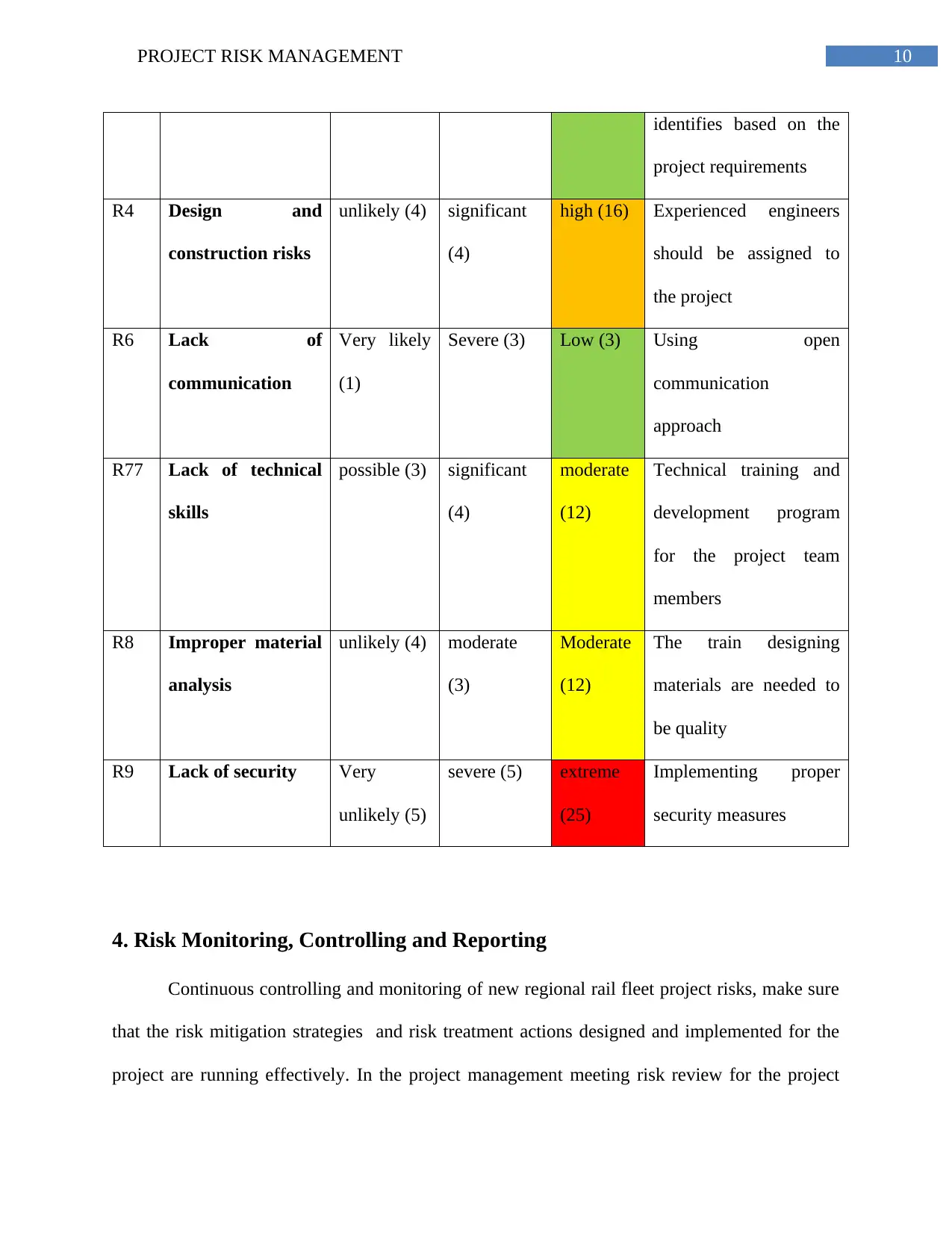
10PROJECT RISK MANAGEMENT
identifies based on the
project requirements
R4 Design and
construction risks
unlikely (4) significant
(4)
high (16) Experienced engineers
should be assigned to
the project
R6 Lack of
communication
Very likely
(1)
Severe (3) Low (3) Using open
communication
approach
R77 Lack of technical
skills
possible (3) significant
(4)
moderate
(12)
Technical training and
development program
for the project team
members
R8 Improper material
analysis
unlikely (4) moderate
(3)
Moderate
(12)
The train designing
materials are needed to
be quality
R9 Lack of security Very
unlikely (5)
severe (5) extreme
(25)
Implementing proper
security measures
4. Risk Monitoring, Controlling and Reporting
Continuous controlling and monitoring of new regional rail fleet project risks, make sure
that the risk mitigation strategies and risk treatment actions designed and implemented for the
project are running effectively. In the project management meeting risk review for the project
identifies based on the
project requirements
R4 Design and
construction risks
unlikely (4) significant
(4)
high (16) Experienced engineers
should be assigned to
the project
R6 Lack of
communication
Very likely
(1)
Severe (3) Low (3) Using open
communication
approach
R77 Lack of technical
skills
possible (3) significant
(4)
moderate
(12)
Technical training and
development program
for the project team
members
R8 Improper material
analysis
unlikely (4) moderate
(3)
Moderate
(12)
The train designing
materials are needed to
be quality
R9 Lack of security Very
unlikely (5)
severe (5) extreme
(25)
Implementing proper
security measures
4. Risk Monitoring, Controlling and Reporting
Continuous controlling and monitoring of new regional rail fleet project risks, make sure
that the risk mitigation strategies and risk treatment actions designed and implemented for the
project are running effectively. In the project management meeting risk review for the project
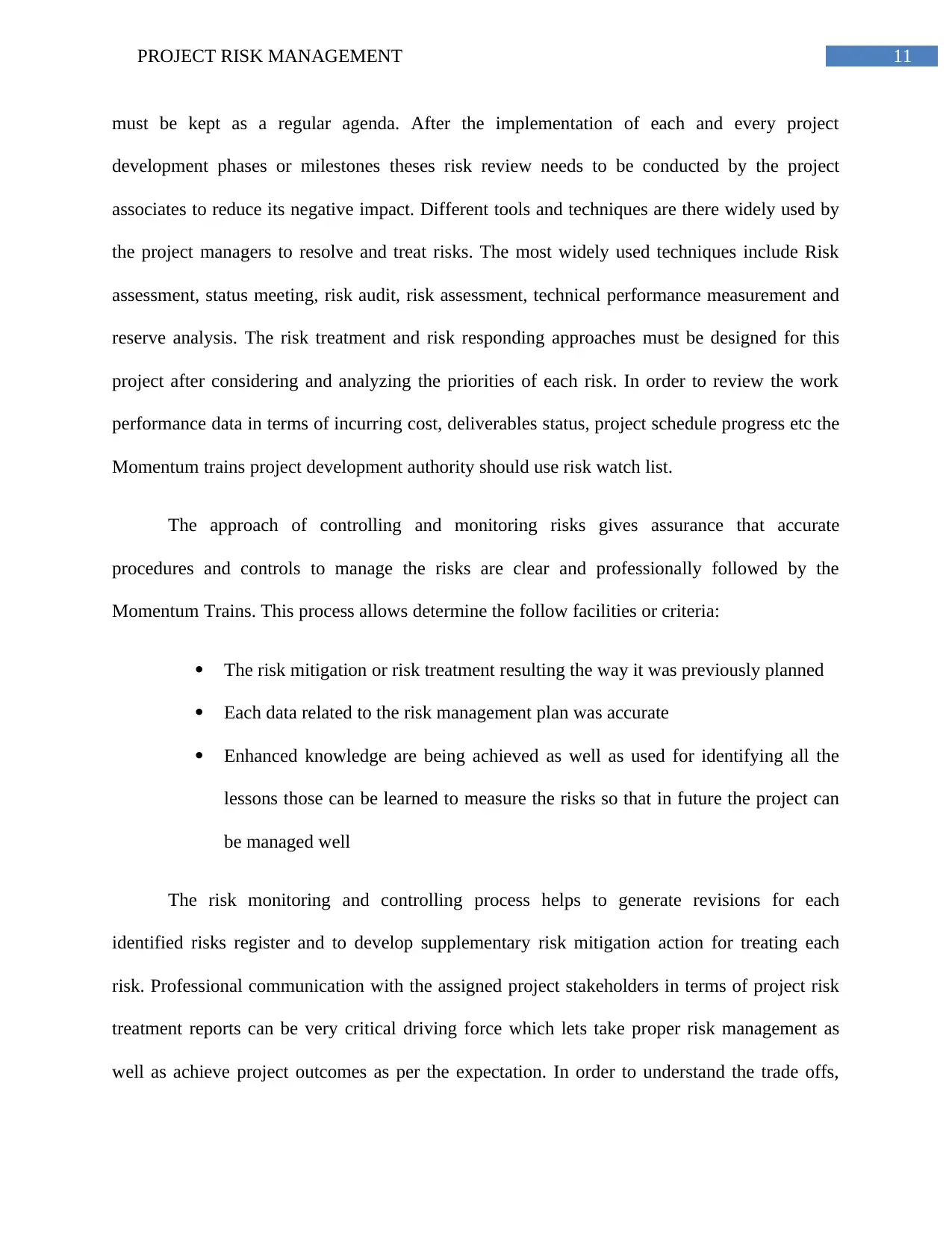
11PROJECT RISK MANAGEMENT
must be kept as a regular agenda. After the implementation of each and every project
development phases or milestones theses risk review needs to be conducted by the project
associates to reduce its negative impact. Different tools and techniques are there widely used by
the project managers to resolve and treat risks. The most widely used techniques include Risk
assessment, status meeting, risk audit, risk assessment, technical performance measurement and
reserve analysis. The risk treatment and risk responding approaches must be designed for this
project after considering and analyzing the priorities of each risk. In order to review the work
performance data in terms of incurring cost, deliverables status, project schedule progress etc the
Momentum trains project development authority should use risk watch list.
The approach of controlling and monitoring risks gives assurance that accurate
procedures and controls to manage the risks are clear and professionally followed by the
Momentum Trains. This process allows determine the follow facilities or criteria:
The risk mitigation or risk treatment resulting the way it was previously planned
Each data related to the risk management plan was accurate
Enhanced knowledge are being achieved as well as used for identifying all the
lessons those can be learned to measure the risks so that in future the project can
be managed well
The risk monitoring and controlling process helps to generate revisions for each
identified risks register and to develop supplementary risk mitigation action for treating each
risk. Professional communication with the assigned project stakeholders in terms of project risk
treatment reports can be very critical driving force which lets take proper risk management as
well as achieve project outcomes as per the expectation. In order to understand the trade offs,
must be kept as a regular agenda. After the implementation of each and every project
development phases or milestones theses risk review needs to be conducted by the project
associates to reduce its negative impact. Different tools and techniques are there widely used by
the project managers to resolve and treat risks. The most widely used techniques include Risk
assessment, status meeting, risk audit, risk assessment, technical performance measurement and
reserve analysis. The risk treatment and risk responding approaches must be designed for this
project after considering and analyzing the priorities of each risk. In order to review the work
performance data in terms of incurring cost, deliverables status, project schedule progress etc the
Momentum trains project development authority should use risk watch list.
The approach of controlling and monitoring risks gives assurance that accurate
procedures and controls to manage the risks are clear and professionally followed by the
Momentum Trains. This process allows determine the follow facilities or criteria:
The risk mitigation or risk treatment resulting the way it was previously planned
Each data related to the risk management plan was accurate
Enhanced knowledge are being achieved as well as used for identifying all the
lessons those can be learned to measure the risks so that in future the project can
be managed well
The risk monitoring and controlling process helps to generate revisions for each
identified risks register and to develop supplementary risk mitigation action for treating each
risk. Professional communication with the assigned project stakeholders in terms of project risk
treatment reports can be very critical driving force which lets take proper risk management as
well as achieve project outcomes as per the expectation. In order to understand the trade offs,
⊘ This is a preview!⊘
Do you want full access?
Subscribe today to unlock all pages.

Trusted by 1+ million students worldwide
1 out of 18
Related Documents
Your All-in-One AI-Powered Toolkit for Academic Success.
+13062052269
info@desklib.com
Available 24*7 on WhatsApp / Email
![[object Object]](/_next/static/media/star-bottom.7253800d.svg)
Unlock your academic potential
Copyright © 2020–2025 A2Z Services. All Rights Reserved. Developed and managed by ZUCOL.





